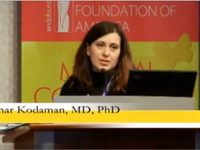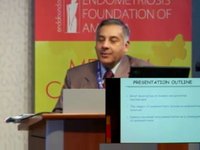Pinar Kodaman, MD, PhD:
Thank you very much for inviting me to speak here today. It is an honor to be here. Today my talk will focus on endometriosis and implantation failure. I will briefly review the known mechanisms of implantation in the human. Then I will focus on what endometriosis does to disrupt this process. I have no conflicts of interest to disclose.
Implantation is the process that involves the attachment, penetration, and embedding of the blastocyst into the lining of the uterine wall , which results in a pregnancy. Here you can see a six-day blastocyst implanting into the endometrium. Implantation is the end result of a process, fertilization occurs on day two after ovulation and there is a process of approximately three days during which the embryo migrates from the fallopian tube into the uterine cavity. By approximately the 8-cell stage it is in the endometrial cavity where it forms up early blastocyst and this blastocyst then hatches out of the shell, so to speak, of the zona pellucida and then implantation can occur. Unfortunately for us who treat infertility, implantation is still really a very – it is sort of the limiting factor oftentimes in success even with advanced reproductive technologies such as in vitro fertilization. As Dr. Fazleabas mentioned there is a very discreet window of implantation where this process can actually occur. It is between days seven to ten after ovulation, so we are in a 28-day cycle with ovulation occurring on day 14 it occurs here during the secretory phase and it is mediated largely in part by the actions of progesterone, which are produced by the corpus luteum as we all know. Progesterone differentiates this previously proliferative endometrium into a secretary receptive one. Interestingly, while blastocysts can implant in many places fairly easily, in the endometrium there is a very discreet timing where implantation can occur.
This is reflected by this elegant study by Woolcox where they measured urinary HCG levels with an ultrasensitive assay and noted that of the pregnancies that preceded beyond six weeks of gestation 84 percent of them occurred during the implantation window, and only a fraction occurred thereafter. So, with delayed implantation there was less likelihood of a successful pregnancy. The flip side of that was that if implantation occurred during the appropriate time the miscarriage rate was quite low, at about 13 percent. However, if implantation was delayed, miscarriage increased about 51 percent. Timing is very important.
The process of implantation is very, very complex and detailed and not fully understood but basically involves the initial recognition of the embryo by the endometrium. There is a crosstalk and synchrony involved here where the embryo initially opposes or unstably attaches to the endometrium and this is mediated by various receptors and ligands and hormones, and eventually the blastocyst can successfully attach to the endometrium and then invade. It invades through the entire endometrium in the upper one third of the myometrium too. It is a very controlled process under tight regulation.
Just briefly to go over some of the mediators of implantation that are important that have been well described the integrins are receptors that bridge the extracellular space to the intercellular space and allow for cell communication between, for example, embryo and endometrium. This particular integrin is expressed by the endometrium during the window of implantation and it is upregulated by progesterone. In addition HOX genes as we have heard are transcription factors, they also mediate the actions of estrogen and progesterone and actually increase again during this window of implantation. HOX genes upregulate the integrin alpha 5 beta 3 which I showed you in the previous slide and also upregulate other mediators of implantation. Interestingly HOXA10 and HOXA11 knockout mice are completely infertile due to implantation defects. They make normal embryos and normal amounts of embryos but these embryos are unable to implant in the endometrium in the mouse model.
Another important mediator of implantation is another cell adhesion molecule L-selectin. It is present on trophoblasts and one of its binding sites is to Mucin, which is like lycra protein that is again expressed by the receptive endometrium. Mucin actually helps in the apposition phase of the interaction and at the point where the embryo actually implants Mucin levels are depleted allowing for the embryo to stick and implant.
Finally, pinopodes are apical projections of the endometrium that are expressed during the window of implantation. Not much is known about them in detail though we do know that there is expression of the integrin and its ligand alpha 5 beta 3 and osteopontin and these pinopodes. It seems that these are important mediators of implantation. Here we see a blastocyst implanting in an endometrium on top of the pinopodes, so it is basically a marker of implantation.
There are many, many other markers of implantation of endometrial receptivity which I do not have time to go into today but are currently being investigated.
Let us for the last few minutes focus on endometriosis and how it impairs fertility. We know that up to 10 percent of women have endometriosis, 40 percent of these women are infertile, and the flip side of that is 50 percent of women with endometriosis have infertility. We know for infertility that the severity of the disease does not predict infertility. You can have very mild disease causing infertility and the disease can be otherwise asymptomatic, so in our patients with unexplained infertility we may find endometriosis in the absence of other symptoms. Women with endometriosis and infertility have a two percent fecundity rate, this is a probability of getting pregnant within a given menstrual cycle compared to 20 or 30 percent in the fertile population. And they have lower conception rates even after assisted reproductive therapy such as in vitro fertilization.
Endometriosis impairs fertility on many, many levels from folliculogenesis to ovulation, sperm function, luteal function but implantation is what we are going to focus on today. One of the problems with endometriosis and implantation is the peritoneal fluid in the setting of endometriosis. This is an ultrafiltrate that is present in normal women, you can see it here in the setting of endometriosis, and it is altered. There are many proinflammatory and growth factors, angiogenic factors that unfortunately have effects beyond the peritoneum. Specifically with respect to sperm functions, sperm oversight interaction as well as implantation. I will go over this briefly since Dr. Fazleabas mentioned some of this.
Integrins affect endometriosis by reducing integrin expression. That is important for implantation, and interestingly when surgery is done or when medical treatment is provided normal levels of this integrin return and improve implantation potentially in women with endometriosis. With respect to HOX genes we know that in endometriosis both HOXA10 in the grey bars and HOXA11 are not adequately upregulated during the window of implantation, which is during the secretory phase, compared to the normal population in black here. So, HOX gene expression is also affected. HOX gene expression when it is affected leads to decreased implantation rates. This appears to be due to hypermethylation of HOXA10 where its affects are then mitigated and permanently silenced.
There are many other altered markers of receptivity in endometriosis, cytokines, the pinopodes are altered, MUC-1, which I went over earlier, is decreased especially with respect to its cytoplasmic domain that results in signaling. There are also other secretory factors, such as glycodelin and IL-1 and also as we saw calcitonin levels are also decreased. These can all alter receptivity in a woman with endometriosis.
Endometriosis affects implantation on many levels. We know from the available data that signaling by cytokines is altered. There is a difference in the integrin receptor profile which may impair the interaction and the crosstalk between the embryo and the endometrium. There are changes in the receptivity of the endometrium based on this and we know that there is progesterone resistance issues that affect how progesterone works, and progesterone in fact is the ultimate generator of all these downstream signals that result in an endometrium being receptive.
With that, we do not have time to talk about treatment options today though surgery, as we will probably hear later, has a modest effect on improving fertility in women with endometriosis. We reserve it for certain patients and have to be careful in the setting of older women, particularly those with endometriomas where surgery may actually diminish their ovarian reserve and further deplete their fertility. There is not much of a role for ovarian suppression in the treatment of natural fertility treatments after endometriosis really infertility though we know that when we suppress women with endometriosis prior to IVF cycle using GnRH agonists for three to six months that some of the negative effects on endometrium are reversed and success rates can actually increase.
Finally, of course, oftentimes the optimal treatment option for implantation failure in endometriosis, and infertility in general with this patient population, are the assistive reproductive therapies such as in vitro fertilization.
Thank you very much.










